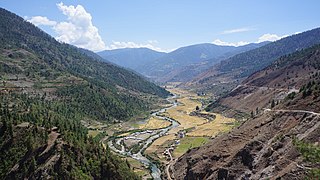Music of Nepal refers to the various musical genres played and listened to in Nepal. With more than fifty ethnic groups in Nepal, the country's music is highly diverse. Genres like Tamang Selo, Chyabrung, Dohori, Adhunik Geet, Bhajan, Filmi music, Ghazal, Classical music, songs and Ratna music are widely played and popular, but many other less common genres are yet to be cataloged. Western musical genres like Rock, Metal, Hip-Hop, Rap, R&B also regularly feature on the Nepalese music charts. Most of the country's musical bands are based in the Kathmandu valley. Musical genres from Tibet and India have greatly influenced Nepalese music.

Nepali Cinema, also referred to as "Nepali Chalachitra" in Nepali, is the filmmaking industry in Nepal. This includes films in various languages of Nepal, most notably in Nepali, Maithili and Bhojpuri. The term Kollywood is also used, as a portmanteau for films produced in the Nepali language while the Nepalese films produced from Kathmandu and Janakpur in the Maithili language is known as Mithilawood. Both of these film industries are the largest viewing cinema of Nepal and are collectively known as Kollywood.

Newar, known officially in Nepal as Nepal Bhasa, is a Sino-Tibetan language spoken by the Newar people, the indigenous inhabitants of Nepal Mandala, which consists of the Kathmandu Valley and surrounding regions in Nepal. The term "Newari" is also used to refer to the language, although it is considered to be a derogatory term by some Newar speakers.

Khas tribe, popularly known as Khashya, according to the 2015 constitution of Nepal are an Indo-Aryan ethno-linguistic group native to the Himalayan region of the Indian subcontinent, in what is now the South Asian country of Nepal, as well as the Indian states of Uttarakhand, Himachal Pradesh, West Bengal, Assam and Sikkim. Historically, Khas were the speakers of an ancient Khas language from the Indo-Aryan language family and the earliest recorded speakers of the Western Pahari languages. The large portion of the Indo-Aryan speakers throughout lower Himalayas were the Khas people. An intrusion of this tribe from the Western and Northwestern Himalayas into Central Himalayas is substantiated by the early linguistic evidences related to the Nepali language. They were also known as Parbatiyas/Parbates and are currently known as Paharis/Pahadis.. They were also referred to as Yartse in Tibet and are also known as Khasan by Bhotia people. The term Khas has now become obsolete, as the Khas people have adopted communal identities because of the negative stereotypes associated with the term Khas. In Nepal the native speaker of Nepali language are known as Khas people.

Chhetri, historically called Kshettriya or Kshetriya or Khas are Nepali speaking Rajputs of Khas community, some of whom trace their origin to migration from medieval India. Chhetri was a caste of administrators, governor and military elites in the medieval Khas Kingdom and Gorkha Kingdom. The nobility of the Gorkha Kingdom mainly originated from Chhetri families. They also had a strong presence in civil administration affairs. The bulk of prime ministers of Nepal before the democratization of Nepal belonged to this caste as a result of the old Gorkhali aristocracy. Gorkha-based aristocratic Chhetri families included the Pande dynasty, the Basnyat dynasty, the Kunwar family, and the Thapa dynasty,.

Jumla District, is one of the ten districts of the Karnali province of Nepal. This district has Jumla as its headquarters, an area of 2,531 square kilometres (977 sq mi); it had populations of 89,427 and 108,921, respectively, in the national censuses of 2001 and 2011. Its territory lies between longitudes 81⁰ 28' and 82⁰ 18' East, and between latitudes 28⁰ 58' and 29⁰ 30' North.
The Nepalese caste system was the traditional system of social stratification of Nepal. The Nepalese caste system broadly borrows the classical Hindu Chaturvarnashram model, consisting of four broad social classes or varna: Brahmin, Kshatriya, Vaishya, Sudra.

Muna Madan is a 1936 Nepali-language episodic love poem written by Laxmi Prasad Devkota. It is about Madan, newly married to Muna, who leaves for Lhasa in Tibet to make his fortune, despite protests from his wife.
The Pahadi people are an indigenous group of the Himalayas. Most Indo-Aryan Paharis, however, identify as members of constituent subgroups and castes within the larger Pahari community such as Brahmin, Kshatriya and Dalits.

Jhākri is the Nepali word for shaman or diviner. It is sometimes reserved specifically for practitioners of Nepali shamanism, such as that practiced among the Tamang people and the Magars; it is also used in the Indian states of Sikkim and West Bengal, which border Nepal. The practice of using a Jhaakri as a channel or medium by a Hindu god or goddess to give solutions or answers to the questions of devotees is known as, "dhaamee " in Nepali.

Jumli or Jumli Khas is an Indo-Aryan language of Nepal closely related to Nepali. It is primarily spoken in the Karnali Province of Nepal. The language is occasionally referred to as a dialect of Nepali; however, the Government of Nepal considers Jumli as a different language and the 2011 Nepal census put the number of native speakers at 851. The Khas language is known as the parent language of Nepali language.
Dahal is a Nepali surname of Khas origin, and also prevalent in some regions of India mainly in Sikkim, Uttarakhand and few parts of Bhutan. The Dahals belong to the Indo-Aryan ethinic group, within the gentry class including Brahmin, Chhetri (ruling) or Rajput castes in accordance to traditional Hindu classification system.
Also spelled as Baskota is a surname of Upadhyay Brahmins from Nepal. Throughout their history in Nepal, they have mostly held vocations as pandit, teachers, purohits, and government officers. Banskotas' gotra is Koudinya.

Khasa-Malla kingdom, popularly known as Khasa Kingdom and Yatse in Tibetan, was a medieval kingdom from the modern day far-western Nepal and parts of Uttarakhand state in India, established around the 11th century. It was ruled by kings of Khasa tribe who bore the family name "Malla". The Khasa Malla kings ruled western parts of Nepal during 11th–14th century. The 954 AD Khajuraho Inscription of Dhaṇga states that the Khasa Kingdom were equivalent to the Gaudas of Bengal and the Gurjara-Pratihara dynasty.

Nepali is an Indo-Aryan language native to the Himalayas region of South Asia. It is the official, and most widely spoken, language of Nepal, where it also serves as a lingua franca. Nepali has official status in the Indian state of Sikkim and in the Gorkhaland Territorial Administration of West Bengal. It is spoken by about a quarter of Bhutan's population. Nepali also has a significant number of speakers in the states of Arunachal Pradesh, Assam, Himachal Pradesh, Manipur, Meghalaya, Mizoram and Uttarakhand. In Myanmar it is spoken by the Burmese Gurkhas. The Nepali diaspora in the Middle East, Brunei, Australia and worldwide also use the language. Nepali is spoken by approximately 19 million native speakers and another 14 million as a second language.

Karnali Province is one of the seven federal provinces of Nepal formed by the new constitution, which was adopted on 20 September 2015. The total area of the province is 27,984 square kilometres (10,805 sq mi), making it the largest province in Nepal with 18.97% of the country's area. According to the 2011 Nepal census, the population of the province was 1,570,418, making it the least populous province in Nepal. The province borders the Tibet Autonomous Region of China to the north, Gandaki Province to the east, Sudurpashchim Province to the west, and Lumbini Province to the south. Birendranagar with a population of 154,886 is both the province's capital and largest city.

Sudurpashchim Province is one of the seven provinces established by the new constitution of Nepal which was adopted on 20 September 2015. It borders the Tibet Autonomous Region of China to the north, Karnali Province and Lumbini Province to the east, and India's states of Uttarakhand and Uttar Pradesh to the west and south, respectively. The province covers an area of 19,539 km2, or about 13.22% of the country's total area.
Historically, the "Thakuri" is one of influential tribe in Nepal that held significant history in Nepal, forming the core of the country's ruling class.
Shweta Punjali is a Nepali musician, well known for her debut album Udaan a number of songs from which were nominated at various national music awards. She is also the winner of the Best New Talent award at the 2016 Nepali Music Video Award and was a nominee for Best Newcomer at the 2015 Tuborg Image Music Award.
Udaan is a Nepali music album launched by singer Shweta Punjali in April 2015. It contains six songs all of which are composed by award-winning Nepali music composer Nhyoo Bajracharya and written by noted Nepali and Newari poet Durga Lal Shrestha.











